The Ecological
Planning Method
The relation of Design with Nature
to the ecological planning method
of identifying competing values.
What does an ecological planning methodology consist of?
This means or method of analysis and synthesis
was first proposed by the late Ian McHarg, (1920-2001), who popularized naturally
appropriate land use planning on CBS, during the late 1950s. He conceived of
the method as an inventory and analysis process
to facilitate assessing the assets and consequences of transportation, new development
and open space protection during the suburban boom period of the 1960s through
the1990s.
guiding principles
interpreted of ecological planning

Introduction by Lewis
Mumford – writer and historian of technology.

Introduction by Lewis Mumford
"In establishing the necessity for conscious
intention, for ethical evaluation, for orderly organization, for deliberate
esthetic expression in handling every part of the environment, McHarg's
emphasis is... Upon the preposition with, which implies human cooperation
and biological partnership."
Lewis Mumford, p.viii.
Contents
| Methodology | Value
Maps | The books' summary | Themes
| Thesis | Return to start
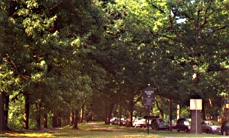
As part of his Boston Park Plan, Frederick Law Olmsted
Jr. Designed this stretch of Jamaica Plain as one element of what is referred
to as "the Emerald Necklace" where features of forests and roadways
are merged to form parkways and greens as open space buffers between south
Boston and adjacent Brookline, Mass.

City and Countryside
Glasgow and the depression, the
surroundings as a respite and source of sustenance.
"Our eyes do not divide us from the world, but unite us
with it."

Let us then abandon the simplicity of separation and
give unity its due. Let us abandon the self-mutilation which has been our
way and give expression to the potential harmony of man-nature.
The world
is abundant, we require only a deference born of understanding to fulfill
man's promise. . . . He must become the steward of the biosphere. To do this
he must design with nature.
page 5.
Contents | Methodology
| Value Maps | The Summary
| Themes | Thesis | Return
to start
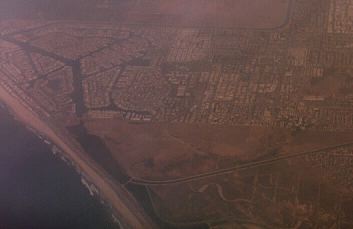
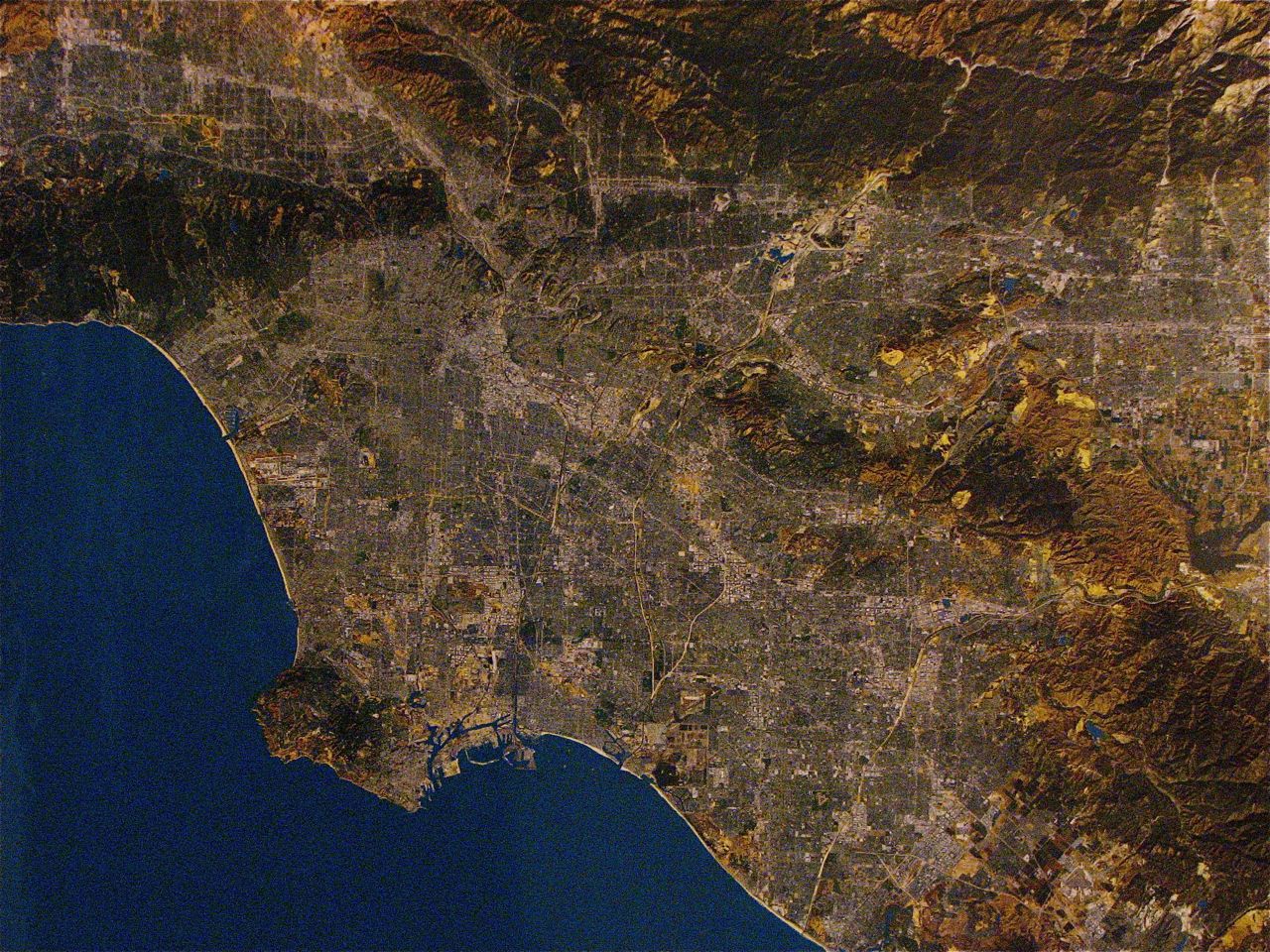
Bolsa Chica, wetland, in Orange County coastal California at the lower right of the above right-hand photograph.
Sea
and Survival
Dunes and the Dutch intelligence
with respect to sea defenses.
Let us accept the proposition that nature is process,
that it is interacting, that it responds to laws, representing values and
opportunities for human use with certain limitations and even prohibitions
to certain of these."
page 7.
"In their long dialogue with the sea the Dutch have learned
that it cannot be stopped but merely directed or tempered, and so they
have always selected flexible construction."

"Perhaps the most reasonable approach would be to investigate
the tolerance or intolerance of the various environments to human use in
general and to some particular uses."
page 13.
Contents | Methodology
| Value Maps | The Summary
| Themes | Thesis | Return
to start
The Plight
page 19
Western commercial, utilitarian and instrumentalist values
have trapped us all.
"The country is not the remedy for the for the industrial
city, but it does offer surcease and some balm to the spirit."
"So when I first encountered the problem of the place
of nature in man's world it was not a beleaguered nature, but merely the
local deprivation that was the industrial city."
"Our failure is that of the western world and lies in
prevailing values." 24
"..dysgenic city and mined landscapes"
Or the functional atrophy of urban cores and peripheries
page 24
25-29 essential, history of eastern (Japan) and western
values (oversimplified).
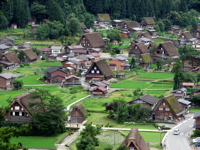
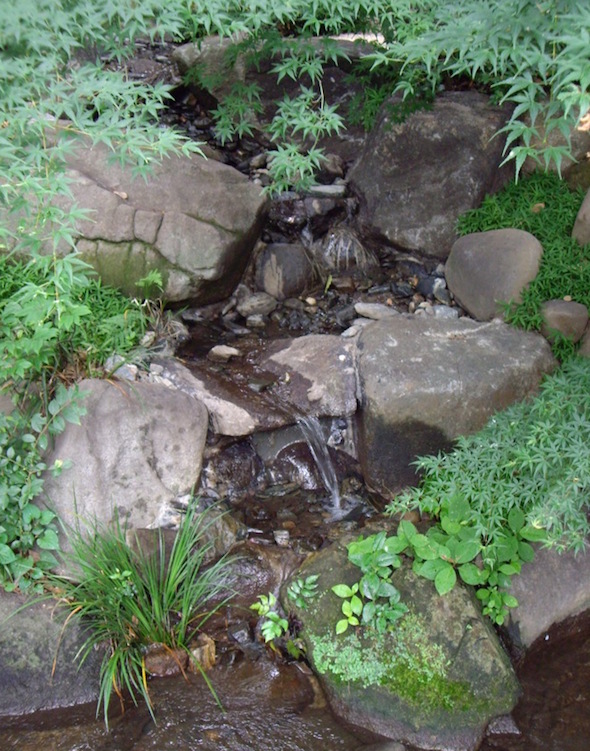

A traditional Japanese village and garden water element is side by side with the traditional interior of a Japanese dwelling; nature defines the space.
Contents
| Methodology | Value
Maps | The Summary | Themes
| Thesis | Return to start
A Step Forward
page 31
Highways and the method is introduced as
a means of delineating landscape uses
"In highway design, the problem is reduced to the simplest
and most commonplace terms: traffic volume, design speed, capacity pavements,
structures, horizontal and vertical alignment."
"In essence the method consists of identifying the area
of concern as consisting of certain processes in land, water an air, which
represent values. These can be ranked..."
page 34
"The method requires that we obtain the most benefit for
the least cost but that we include as values social processes, natural
resources and beauty.
page 34.
Contents
| Methodology | Value
Maps | The Summary | Themes
| Thesis | Return to start
16
values isolated as representing discrete features identifiable on maps.
By using an overlay technique of all 16 maps a composite image emerges
of the ecological and social advantages based on varied, existing uses
of landscapes.
Slope, surface
drainage, soil drainage,
bedrock
foundation, soil foundation,
erosive capacity,
land
values, tidal inundation,
| historic values,
scenic
values, recreational values,
| water values,
forest
values, wildlife values,
residential values,
institutional
values.
pp. 37-38.
Contents
| Methodology | Value
Maps | The Summary | Themes
| Thesis | Return to start
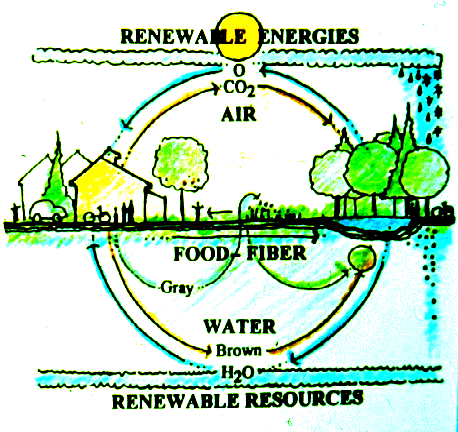
The Cast and the Capsule
page 43.
An alleged digression into the science,
forms and functions of the biosphere's role.
 "Think then of the great work of the sun (describes the
flow of energy & water)
"Think then of the great work of the sun (describes the
flow of energy & water)
page 47
Consistency of the atmosphere, 20% O-2 78% nitrogen
page 48
Identified major actors of the biosphere -- the encompassing
envelope that is our milieu -- the atmosphere, that membrane around the
earth..."
page 50
water acts on land surfaces, and through erosion and sedimentation
changes these surfaces towards equilibrium."
"Entropy is the rule."
Contents | Methodology
| Value Maps | The Summary
| Themes | Thesis | Return
to start
Nature
in the Metropolis
page 55.

Philadelphia and the decisions with respect
to open space allocation of land & water.
"... The diagnostic and prescriptive powers of a rudimentary
ecology carried more weight and had more value."
Philadelphia metropolitan region as an example of finding
the place of nature in the metropolis by a means of reserving "open space."
"reasonable to suggest that nature performed work for
man without his investment and that such work did represent a value."
page 55
Contents
| Methodology | Value
Maps | The Summary | Themes
| Thesis | Return to start
On Values
page 67.
Our continent of North America is described
before human contact and contrasted with the coming of the Europeans and a revolution
in ideas and land-use based on water acquisition and mineral wealth at the end
of the pre-Columbian (1492) period.
"The emergence of the seed in Jurassic times (250,000,000 years
ago) precipitated the explosion of the flower"
"This new devastating tool was fire."
"If one can infer from the ways of the North American Indians,
there evolved a most harmonious balance of man and nature."
"The authority of man was made visible by the imposition
of a simple Euclidean geometry upon the landscape, and this is seen to
increase within the period (after Columbus). Man imposes his simple entertaining
illusion of order, accomplished with great art, upon an unknowing and uncaring
nature. The garden is offered as a proof of man's superiority."
page 71.
"Here the ornamental qualities of plants are paramount --no ecological
concepts of community or association becloud the objective.
Plants are like "man's companions, sharing his domestication."
page 71.
Contents
| Methodology | Value
Maps | The Summary | Themes
| Thesis | Return to start
A
Response to Values
page 79.
The Maryland suburbs (Washington DC and Baltimore
axis) were, in the 1960s, beginning to threaten rural and woodlands so a means
was devised of participatory decision making among local owners and regional councils
and wider public interests in order to protect shared aesthetic and natural values.
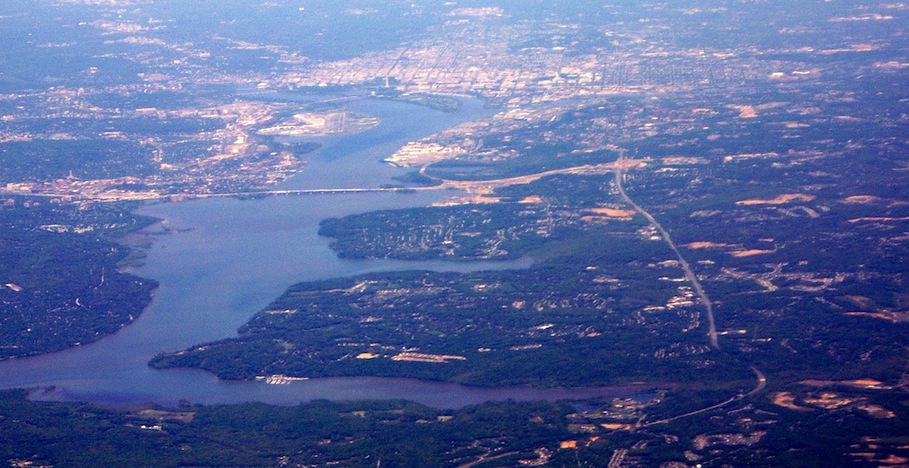
The Potomac River shown here slices through the Piedmont Plateau to descend relatively quickly to the Atlantic coastal plain where the northern cooler adjusted forests meet the warmer forest of the lowlands. As part and parcel of the Chesapeake Bay watershed, the Potomac River is the largest tributary of the bay but suffers from suburban sprawl, despite the attempt of the District of Columbia to build a modern extensive and efficient high speed underground rail system to alleviate the traffic that so congests the Capital city and pollutes the air and watershed.
Contents
| Methodology | Value
Maps | The Summary | Themes
| Thesis | Return to start
The World is a Capsule
page 95.
"To learn about the evolution of physical and biological
processes is an indispensable step toward the knowledge one needs before making
changes to the land: but it is far from enough."
page 96.
"the objectives remain unchanged: to create a self-sustaining
ecosystem –whose only import is sunlight, whose only export is heat-- sufficient
to sustain man for a certain period of time."
page 96
"We need to demonstrate creative, rather than destructive
skills, if we are to replicate nature or to manage it."
"The distribution of the essential nutrients is an important
consideration, and lacking any better information, it is concluded that these
will exist ...provided the water, soil, and creatures of the ecosystem are healthy."
page 98
Contents | Methodology
| Value Maps | The Summary
| Themes | Thesis | Return
to start
Processes of Values
page 103.
The geographical location, topography and
shape of Staten Island (Borough of Richmond; fifth in size of the five
boroughs that comprise New York City) make it an ideal place to apply the principles
of ecological planning to an urban and suburban setting to protect hydrological,
scenic and cultural features.
Contents | Methodology
| Value Maps | The Summary
| Themes | Thesis | Return
to start
The Naturalists
page 117.
The role of naturalists in discovering evolution
and ideas of natural selection, cooperation among species, zonation (specialized
demarcations in the natural field where plants grow and adapt to soils and water)
succession, climax and retrogression (due to stress from natural or artificial
conditions) is described. These become the elements of ecology and they inform
the ecological view of planning.
Contents
| Methodology | Value
Maps | The Summary | Themes
| Thesis | Return to start
The
River Basin
page 127.
The Potomac Valley and the interdependence
of physiography and hydrology.
"At least the river basin is describable-- it is
united by water; and it is permanent."
The river basin is a hydrological unit, it is not a physiographic
one..."
"physiographic regions vary dramatically."
"In earlier applications of the ecological planning method,
the problem s all contained certain limitations."
page 127.
Good summary of book to this point
page 127.
Ecological Planning Method developed more fully:
"The first considerations are historical geology and climate
which, in conjunction, have interacted upon the river basin, for they have
created the basic form."
Basic Considerations in regional planning:
Geology

Physiography
Hydrology
Plant associations
Wildlife
Water Problems
Interpretation
Mineral resources
Accessibility
Water Resources
Intrinsic Suitabilities
Agriculture
Forestry
Recreation
Urban

Three guiding principles
-
Degree of Compatibility
-
Optimize multiple land uses
-
Know the physiographic regions

"Such is the method-- a simple sequential examination
of the place in order to understand it. This understanding reveals the
place as an interacting system, a storehouse, and a value system."
page, 151.
Contents | Methodology
| Value Maps | The Summary
| Themes | Thesis | Return
to start
The Metropolitan Region
page 153.
Contents
| Methodology | Value
Maps | The Summary | Themes
| Thesis | Return to start
Process and Form
page 163.
Contents
| Methodology | Value
Maps | The Summary | Themes
| Thesis | Return to start
The City: Process & Form
page 175.
Placement and memorial settings in the design
of Washington DC from the geology and hydrography to vegetation and architecture.
Contents
| Methodology | Value
Maps | The Summary | Themes
| Thesis | Return to start
The
City: Health and Pathology
page 187.
Public spaces and the detachment of people
from one another in communities
"There is no generally accepted definition of health,
and the medical professions are entirely concerned with disease."
Common (mass) sense versus professional (expert) knowledge
as sub cultures are compared.
". . . the central proposition of this book has been that
creativity and destruction are real phenomenon, that both have attributes,
that fitness and unfitness –in the evolutionary sense– are expressions
of these, as are health and disease."
page 195.
Contents
| Methodology | Value
Maps | The Summary | Themes
| Thesis | Return to start
Prospect
page 196.
Contents
| Methodology | Value
Maps | The Summary | Themes
| Thesis | Return to start
The Summary
Urban growth has the power to obliterate
essential features that signify vital functions, primary values and cultural
landscapes unless the definitive method of ecological planning is used to examine
and explain essential characteristics of an area.
Themes
Knowledge of the land, the water, and the
air is rapidly vanishing.
Defining the importance of knowing physical,
chemical, biological, cultural and social limitations.
The context of the milieu witching which
we all dwell: our planet, as a physical shell coupled with its biosphere, or
the living penumbra is the starting point for identifying, inventorying and
describing the natural and cultural worth of all the features in a terrain.
The Thesis
Trapped by our own behavioral demands,
limited knowledge and socioeconomic considerations the human transformation
of the planet through urban, agricultural and industrial land-use and land-use
changes threatens the long-term existence of human society unless we apply
a rigorous knowledge based understanding of ecology to our daily affairs,
industrial design and patterns of resource exploitation.
Summary
Interpreting the guiding principles of ecological planning.
Degree of Compatibility
- higher value is given to land-use patterns that complement one another such
as retaining features for scenic qualities, watershed protection, noise abatement
and appropriate buffers.
Optimize multiple land uses -
solving more than one problem with the same activity is better than one
solution at a time with numerous land consuming activities.
Know the physiographic regions - place geology,
hydrology and native vegetation at the start of the planning process.
ecological thinking
development of ecological thought
Contents
| Methodology | Value
Maps | The Summary | Themes
| Thesis | Return to start
Planning Index
| Analytical Planning | Criteria
| Places | Geographical
Intelligence | Community
Bulldozer in the Countryside









 "Think then of the great work of the sun (describes the
flow of energy & water)
"Think then of the great work of the sun (describes the
flow of energy & water)


